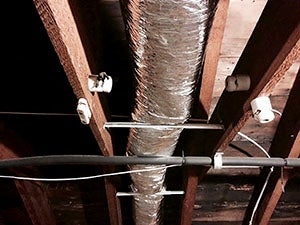Electrical wiring gives history lesson
Published 6:18 pm Saturday, February 14, 2015

Examples of knob and tube wiring in the Hormel Historic Home. Photo provided
Over the last couple of weeks I have had a crash course in 1900’s electrical wiring.
In case you are unfamiliar, a common method for bringing electricity into a facility was through the use of knob and tube wiring. Based on the recommendation (read requirement) of our insurance company, we have recently had our “historic” wiring removed and replaced with acceptable modern day materials. Though not a project we had planned to undertake, based on the amount of wiring the electricians found and the amount of electricity we use, it has turned out to be a positive venture.
Following is knob and tube 101 in case you are curious. Some of it is Greek to me.
From Oldhouseweb.com, “Fairly common in houses built before 1930, the system uses porcelain insulators (knobs) for running wires through unobstructed spaces. Porcelain tubes protect wires that run through studs and joists. Some of the safety features of the system are porcelain knobs suspend the wire in open air to dissipate heat, wiring was usually installed along the center of joists and studs away from potential nail punctures, additional protection provided by porcelain tubes where it passes through wood, and wires were usually never loose or placed on top of joists where they could be easily damaged.”
From Wikipedia.com “Knob and tube wiring (sometimes abbreviated K&T) was an early standardized method of electrical wiring in buildings, in common use in North America from about 1880 to the 1930s. It consisted of single-insulated copper conductors run within wall or ceiling cavities, passing through joist and stud drill-holes via protective porcelain insulating tubes, and supported along their length on nailed-down porcelain knob insulators. Where conductors entered a wiring device such as a lamp or switch, or were pulled into a wall, they were protected by flexible cloth insulating sleeving called loom.”
I have not confirmed the timing for the installation of electricity in the Hormel home. There is record of an Electric Light Co. doing business in Austin in 1889. George and Lillian purchased this home in 1901 and did extensive remodeling. It is possible the knob and tube was added then, but it might be that the original owners, the Cook family, had added it earlier.
Regardless of who put it in, the technology of the early 20th century has served us well. I just hope the new technology lasts as long.
Board of Directors
4 p.m., Monday
Social Concerns: The Value of a Musical Education
10 a.m., Tuesday
Presented by Brad Mariska, Austin High School band director. This is a free event, refreshments served. Please call to reserve a seat.


